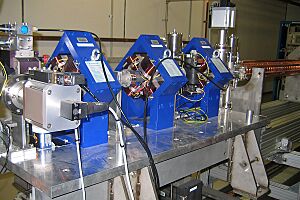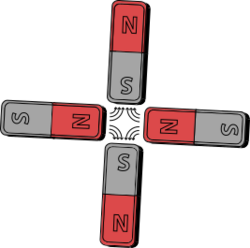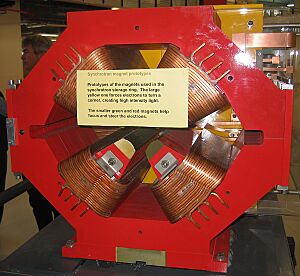Quadrupole magnet facts for kids
A quadrupole magnet is a special kind of magnet made from a group of four magnets. Imagine arranging four bar magnets in a square, with their north and south poles alternating so they face the center. This setup creates a unique magnetic field that is very weak in the middle but gets much stronger as you move away from it.
This special property makes quadrupole magnets perfect for focusing beams of tiny particles. They work like a lens for a particle beam, squeezing it to keep it on the right path.
The simplest way to make a magnetic quadrupole is to place two bar magnets next to each other, with the north pole of one next to the south pole of the other. However, much stronger quadrupoles are made using electromagnets. These have four steel tips (poles)—two north and two south—that are magnetized by a powerful electric current flowing through coils of wire.
Contents
Quadrupoles in Particle Accelerators

One of the most important jobs for quadrupole magnets is in particle accelerators. These are huge machines that make tiny particles, like electrons or protons, travel at nearly the speed of light.
At such high speeds, it's hard to keep the particles in a tight beam. They tend to spread out, like water from a hose. To steer and focus these super-fast particles, scientists use powerful magnets. Because the particles are moving so fast, magnetic forces are much better at steering them than electric forces. Quadrupole magnets act like super-strong lenses for these particle beams, squeezing them to keep them from spreading out.
A Clever Focusing Trick
There is a tricky thing about quadrupole magnets: they can't focus a beam in all directions at once. A single quadrupole magnet will focus the beam horizontally but actually make it spread out (defocus) vertically. Or, it can focus vertically but defocus horizontally.
To solve this problem, scientists use a clever trick. They place a series of quadrupole magnets one after another along the beam's path.
- A 'focusing' (F) magnet squeezes the beam in one direction.
- A 'defocusing' (D) magnet, placed a short distance away, squeezes the beam in the other direction.
By alternating these F and D magnets with spaces in between, the overall effect is that the beam gets focused in both directions. This pattern allows scientists to keep the particle beam narrow and on track over very long distances, even all the way around a giant circular accelerator.
The Need for Steady Power
For these magnets to work perfectly, they need an extremely stable supply of electricity. The power supplies that run them are designed to provide a very precise electric current that doesn't change. If the current changed even a tiny bit, the magnetic field would also change, and the particle beam could go off course and crash into the wall of the accelerator.
See also
- Charged particle beam
- Dipole magnet
- Electron optics
- Halbach cylinder
- Sextupole magnet
- Multipole magnet
- Accelerator physics




